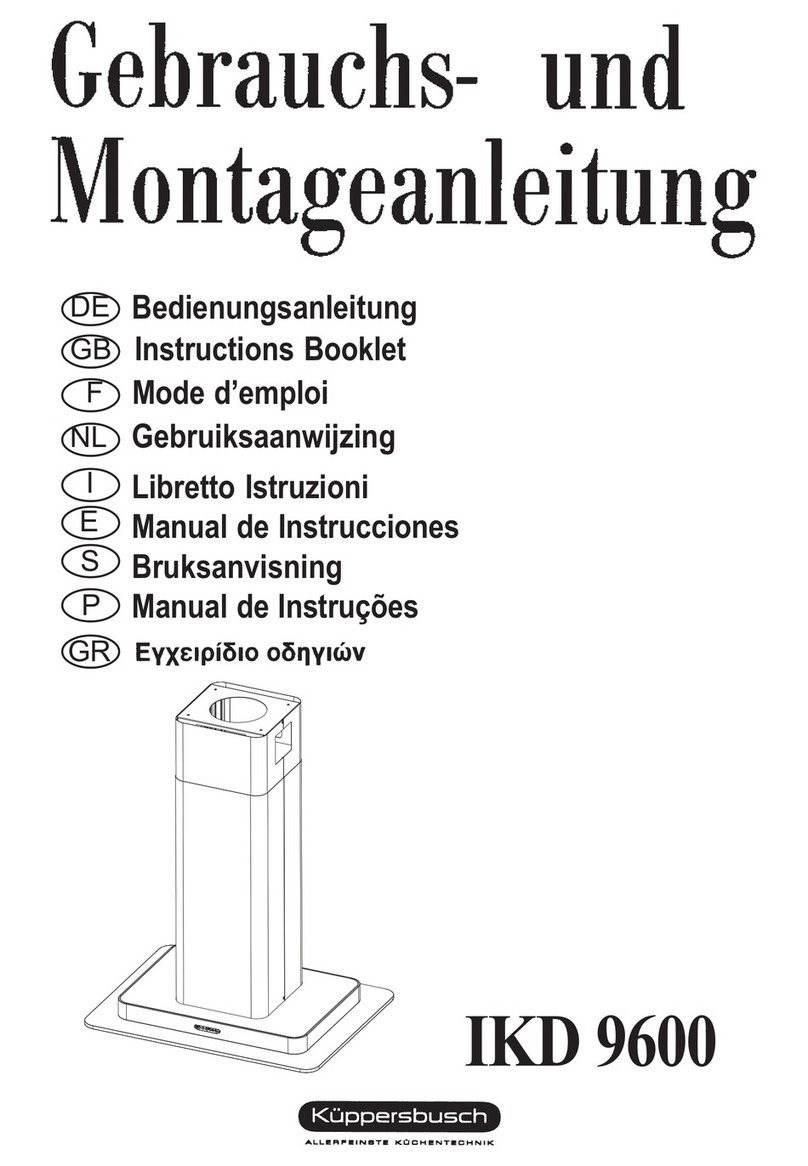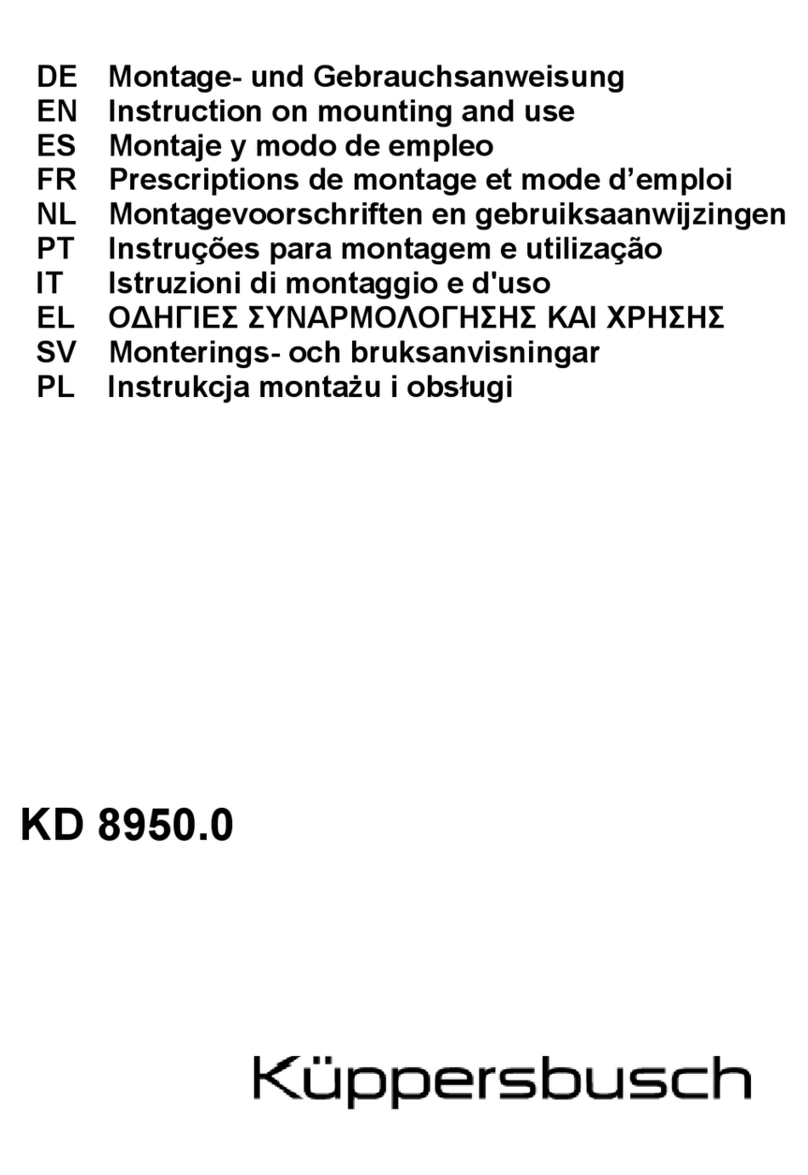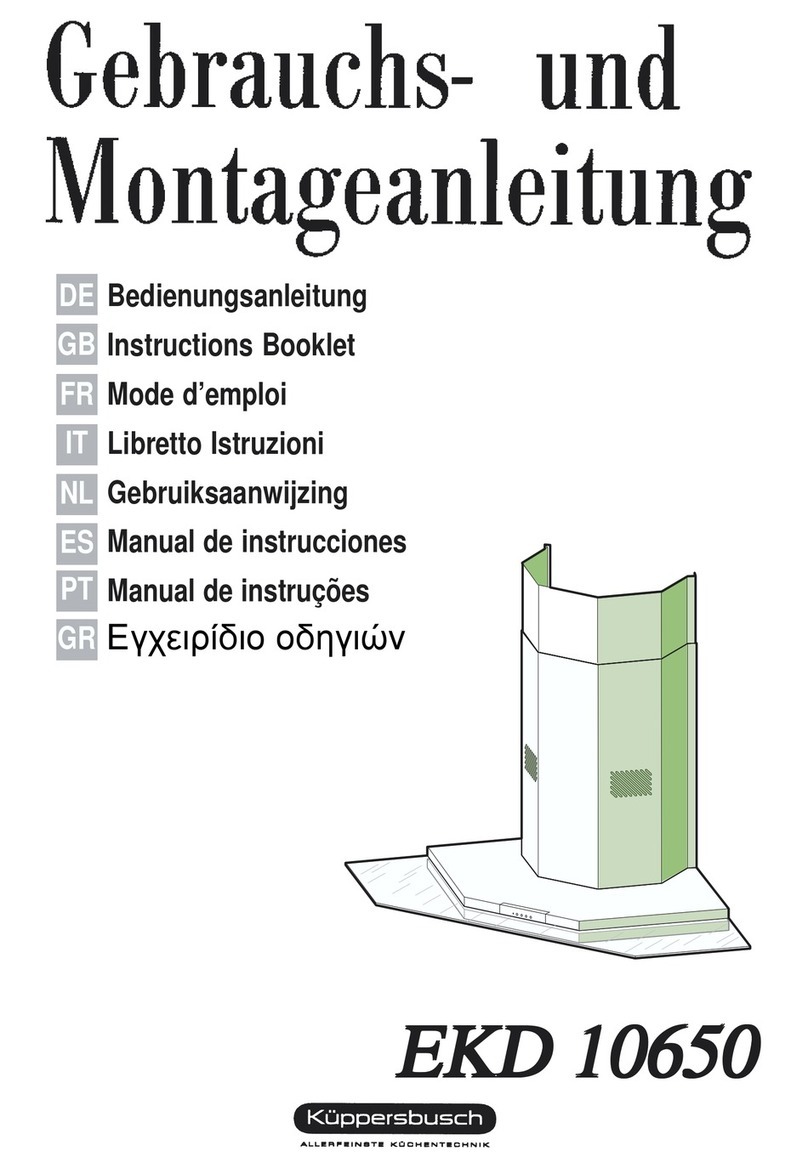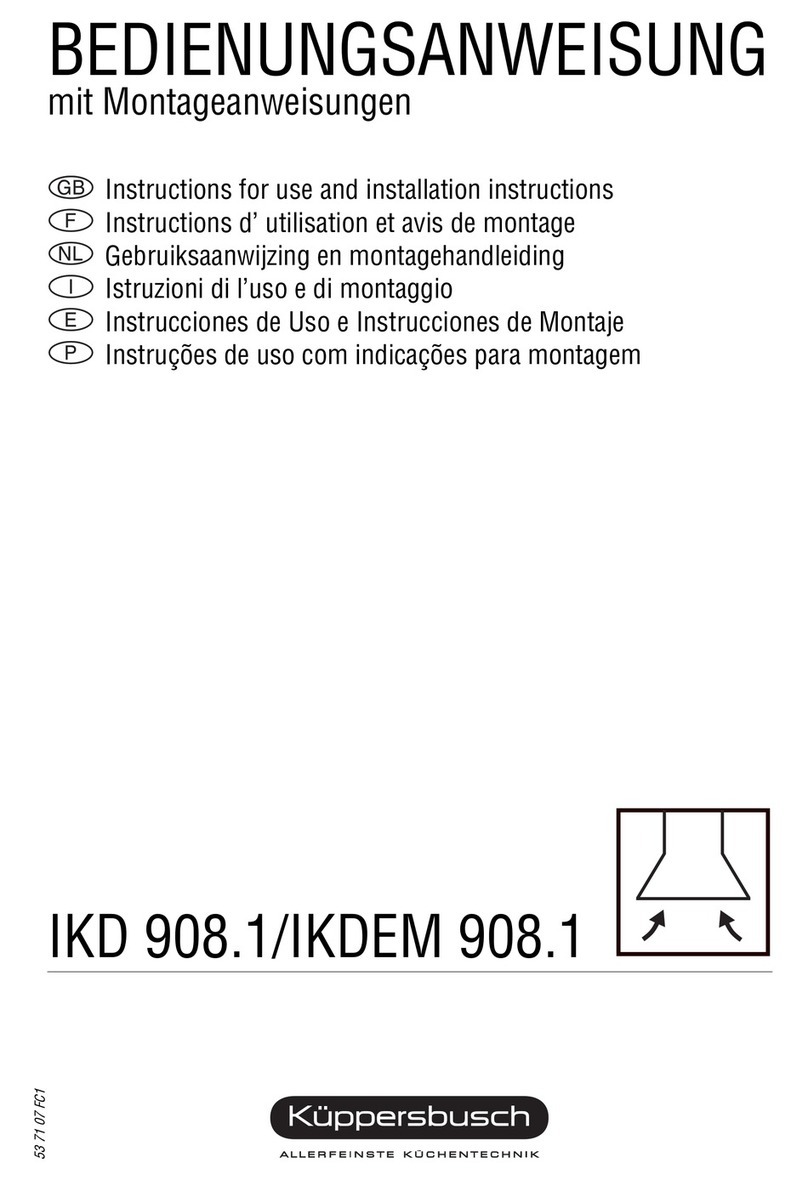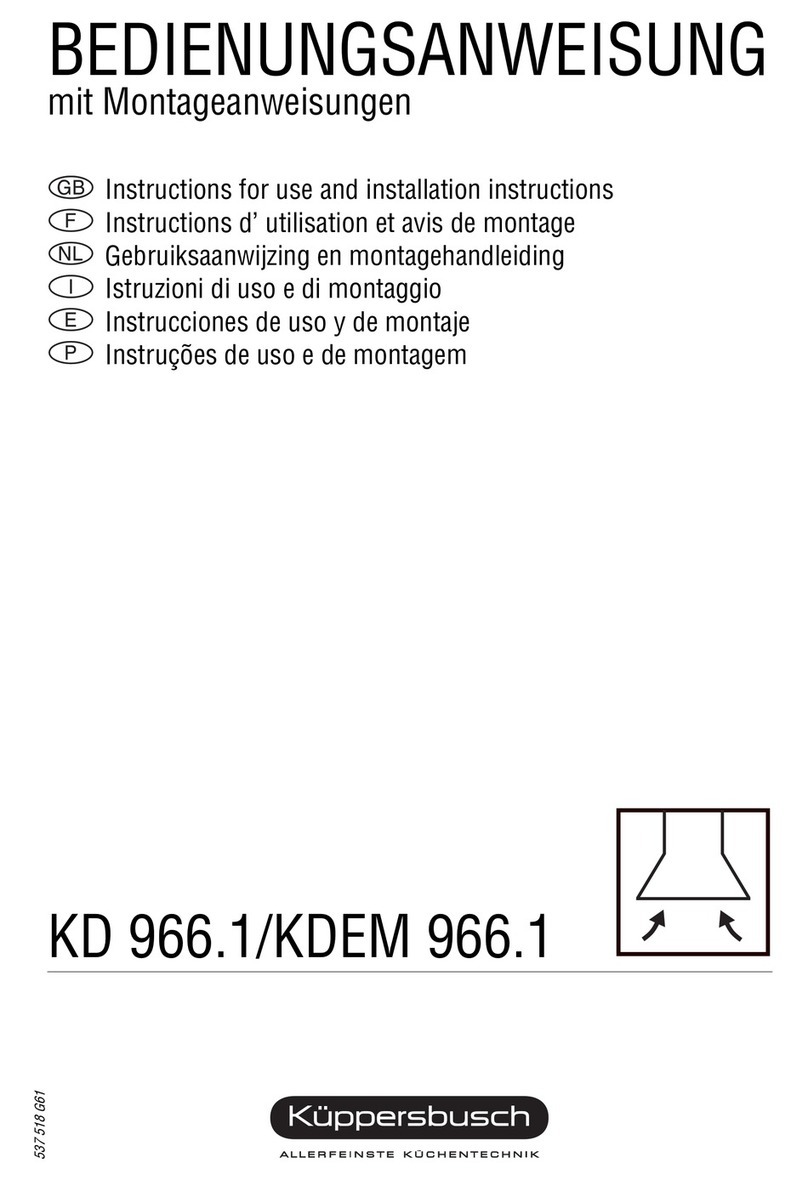herzustellen, das mit dem Motor geliefert
wird. Das Kabel ist im entsprechenden
Anschlußgehäuse des Geräts
anzuklemmen. Das Anschlußgehäuse
befindet sich neben dem Abluftstutzen des
Gerätes und ist mit dem Hinweisschild
"Externer Motor" gekennzeichnet. Zum
Anschluß des Kabels öffnet man den Deckel
des Anschlußgehäuses (Abb. 7A + B),
schließt das Kabel an den hierfür
vorgesehenen Klemmen (Abb. 7C) an und
schließt den Deckel wieder. Zum Öffnen und
Schließen des Deckels löst bzw. schließt
man die Deckelverschraubung.
Die Haube gegen den Oberschrank
drücken und mit den 4 mit dem Gerät
gelieferten selbstschneidenden Schrauben
befestigen.
Bei Abluftversion sowohl mit Motor wie auch
für externen Motor: Luftausgangsstutzen des
Gerätes und Lüftungsloch, das in der Wand
vorbereitet wurde, mit Hilfe eines geeigneten
Schlauches verbinden. Das Gerät an das
Stromnetz anschließen. Fettfilter wieder
anbringen.
Bei Umluftversion: An den Luftstutzen einen
geeigneten Schlauch anschließen, damit die
Luft wieder in den Raum zurückgeführt wird.
Das Gerät an das Stromnetz anschließen.
Den Kohlefilter montieren und darauf
achtgeben, dass er sich einwandfrei den Rand
A entlang einklemmt (Abb. 8). Fettfilter wieder
anbringen.
SCHALTUNGDESGERÄTS
--------------------------------------------------------
Steuerungen (Abb. 9):
SchalterD: aufStellung A(automatisch) wirddie
Motor-undLichtzündungautomatischdurch
dasÖffnen oderSchliessen desAuszugteils
geregelt. Auf Stellung M (handbetätigt) ist
das Licht eingeschaltet, bei Stellung O
hingegen ausgeschaltet.
BeiteilweisegeöffnetemAuszugteilläuftderMotor
auferster Geschwindigkeit. Öffnet man nochein
wenig, so hat man Geschwindigkeit II und bei
vollständigem Öffnen Geschwindigkeit III.
Fallsdas Gerätin Umluftversionbenutzt wird, so
ist es notwendig, die Aktivkohlefilter je nach
Benutzungsdauer zu ersetzen, das heißt
mindestens alle 6 Monate.
– Schiebegestell nach vorme ziehen und
öffnen;
– Entfettungsfilter wegnehmen: in
Übereinstimmung mit dem Handgriff den
Feststeller nach immem stossen und den
Filter nach unten ziehen (Abb. 4).
– Die Lasche des Aktivkohlefilters erfassen,
nach dem Hinterteil des Gerätes und
gleichzeitig nach unten ziehen (Abb. 8/
10). Achtung bitte: um den Kohlefilter zu
montieren, ist es notwendig, dass er sich
einwandfrei den Rand A entlang einklemmt
(Abb. 8).
Wechsel der Halogenlampen
Beim Lampenwechsel ist zu beachten daß nach
längerem Betrieb des Gerätes die Lampen sehr
heißwerden.EsempfiehltsichdaherdieLampen
in abgekühltem Zustand zu wechseln. Die
HalogenlampenniemitbloßenFingernanfassen!
Zunächst ist die Lichtabdeckung zu öffnen
(Abb.11). Nun kann die Halogenlampe
gewechselt werden. Im Austauschfall sind
unbedingt Halogenlampen des selben Typs zu
verwenden. (Leistung 12V, Spannung 20W,
Fassung der Halogenlampe G4)
WARNING
--------------------------------------------------------
The distance between the supporting
surface for the cooking vessels on the hob
and the lower part of the hood must be at
least 65 cm. If the instructions for installation
for the hob specify a greater distance, this
has to be taken into account.
The air collected must not be conveyed
into a duct used to blow off smokes from
appliances fed with an energy other than
electricity (central heating systems, ther-
mosiphons, water-heaters, etc.).
Comply with the official instructions provided
by the competent authorities in merit when
installing the disposal duct. In addition,
exhaust air should not be discharged into
a wall cavity, unless the cavity is designed
for that purpose.
The room must be well aerated in case a
hood and some other heat equipment fed
with an energy other than electricity (gas,
oil, coal heaters, etc) operate at the same
time. In fact the intake hood, disposing of
air, could create a vacuum in the room.
The vacuum should not exceed 0,04mbar.
This prevents the gas exhausted by the
heat source from being intaken again. It is
therefore advisable to ensure the room
contains air taps able to ensure a steady
flow of fresh air.
Check the data label inside the
appliance; if the symbol ( ) is printed,
read the following: this appliance has
such technical particulars that it
belongs to class II insulation, therefore
it must not be earthed.
The following warning is valid in the United
Kingdom only: as the colours of the wires
in the mains lead of this appliance may not
correspond with the coloured markings
identifying the terminals in your plug,
proceed as follows:
– the wire which is coloured blue must be
connected to the terminal which is marked
with the letter N or coloured black;
– the wire which is coloured brown must
be connected to the terminal which is
marked with the letter L or coloured red.
English
– terminal of a three-pin plug.
Check the data label inside the applian-
ce; if the symbol ( ) is NOT printed,
read the following: ATTENTION: This
appliance must be grounded. When
making the electrical connections, check that
the current socket has a ground connection.
The following warning is valid in the United
Kingdom only: as the colours of the wires
in the mains lead of this appliance may not
correspond with the coloured markings
identifying the terminals in your plug,
proceed as follows:
– the wire which is coloured green and
yellow must be connected to the terminal
in the plug which is marked with the letter
E or by the earth symbol [ ], or coloured
green or green and yellow;
– the wire which is coloured blue must
be connected to the terminal which is
marked with the letter N or coloured black;
– the wire which is coloured brown must
be connected to the terminal which is
marked with the letter L or coloured red.
When making the electrical connections,
check that the voltage values correspond
to those indicated on the data plate inside
the appliance itself.
In case your appliance is not furnished with
a non separating flexible cable and has no
plug, or has not got any other device ensu-
ring omnipolar disconnection from the elec-
tricity main, with a contact opening distance
of at least 3 mm, such separating device
ensuring disconnection from the main must
be included in the fixed installation. If your
unit features a power lead and plug, position
this so the plug is accessible.
Always switch off the electricity supply before
carrying out any cleaning or servicing
operations on the appliance.
USE
--------------------------------------------------------
Avoid using materials which could cause
spurts of flame (flambées) near the ap-
pliance.
When frying, take particular care to prevent
oil and grease from catching fire. Already
used oil is especially dangerous in this re-
spect. Do not use uncovered electric grates.
To avoid possible risks of fire always comply
with the indicated instructions when cleaning
anti-grease filters and when removing
grease deposits from the appliance.


